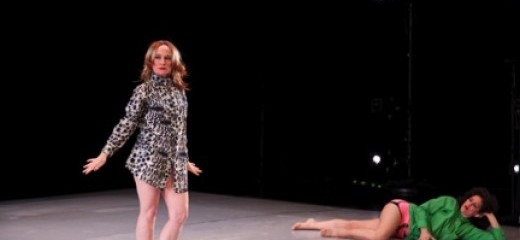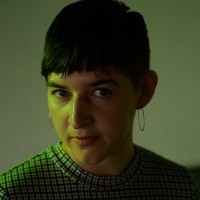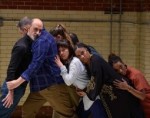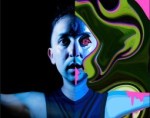
Queer Dance is Capacious
by Miryam Coppersmith
When I read a book that grips me, I often share passages with loved ones.
“‘Queer’ … is a term borne of physical, collective action,” I read to my collaborators over video chat from Clare Croft’s introduction to Queer Dance: Meanings and Makings (9). I delight over Angela K. Ahlgren's description of Taiko, “music-as-dance,” with my partner, a drummer and collaborator (233). thomas defrantz writes “queer dance is a distortion, hopefully in a useful way, toward something unanticipated and awe-ful (awful) that exists now, here, and for this gathered community” (178). Queer Dance pulled me into this gathered/distributed community of queer makers with a wink, a shimmy, and a wake-up shake-up all at once.
The Queer Dance project is not just a book; it’s also a series of performances that took place at the University of Michigan in the mid-2010s, a video archive of those performances, and a video archive of interviews with the artists and scholars featured. No piece of the project is intended to be central or authoritative, a structure that supports the queer artists inside it repeatedly eschewing centralization or the establishment of authority about their work, the field of dance, or queerness itself. Croft, Professor of Dance at the University of Michigan, edited the book, curated the performances, and conducted the interviews. In her introduction, she prepares the reader with this intention: “I hope people feel productively disturbed by their encounters with the capacious archive that is Queer Dance: Meanings and Makings” (7).
The book is divided into three sections; Queering the Stage, Dancing Towards a Queer Sociality, and Intimacy, though major themes flow among the sections with queer fluidity. In “The Hysterical Spectator,” Doran George uses Jennifer Monson and DD Dorvillier’s RMW(A) & RMW as a jumping-off point to examine how works from the ‘90s and ‘00s perform gender critique. George alternates between the transgender, feminist, and queer viewers within themself, articulating these different viewers' desires and analyses. This clarified my own viewing experiences, bringing words to the friction I experience when a piece satisfies my feminist viewer but leaves my queer self questioning. Later in the book, we see RMW(A) & RMW again but through Monson’s eyes. She brings us into the interior of the piece, opening with a score of her own sensations, emotions, and thoughts while performing it. The video archive allows me to watch RMW(A) & RMW and have my own experience of the piece.
Many of the essays are written by the artists, echoing queer need for self-definition and delight in playing with self-presentation. The authors are frank about the ways their theories and research touch their lives directly and boldly write in the messiness of their lives. In contrast, the last essays in Queering the Stage look at historic dance pieces like Swan Lake and Anna Sokolow’s Rooms through the eyes of outsider queer scholars. They knowingly “read into” the pieces, employing deep analysis into costume design, Labanotation, and choreography to expose queer potentiality in works not explicitly labeled “queer” by their creators.
Emily Wilcox’s “Women Dancing Otherwise” employs similar techniques to read into Right & Left by contemporary Chinese choreographer Gu Jiani. Wilcox is clear from the outset that her writing evinces her queer feminist reading of the work, not Gu’s intent. Wilcox, Associate Professor of Chinese Studies at William & Mary College, provides valuable context about Chinese dance training and queer politics, using this knowledge to fuel her analysis. However, Gu’s statements about Right & Left reveal a more universal, humanistic, and not explicitly queer approach to creating the dance. I question whether Wilcox’s framing stems from the idea that white audiences need context from a white insider to understand non-white culture. Gu, translated by Wilcox in their interview, says that her inclusion in Queer Dance does not contradict her creative vision: “Because of the way the book is designed, you’re really allowing people to see the work themselves... so that in itself means you’re not saying the work has to be read in this way...”
The writing in Queer Dance is its own lyrical, rhythmic, rebellious dance. In moments, the authors bring their knowledge of the body and language to challenging real-life moments. In the last essay of the book, “Expressing Life through Loss: On Queens that Fall with a Freak Technique,” artist and choreographer Anna Martine Whitehead describes the physical responses of their housemates after the police broke into their home and arrested one of their friends.
Afterward, we shook… I have never seen Yemi’s body look the way it did for those next nine hours: without bones. Their rib cage and shoulder girdle melted away and their spine struggled to hold up all the muscles. Yemi’s skin sagged off their spine like this; even their cheekbones pulled downward. I don’t remember what I did with my body… (285).
Queer Dance refuses to stay neatly in its book binding the way queer dance makers refuse to stay neatly in proscenium squares. The theory/analysis/critique spill out into all areas of life, a reminder of how relevant body-based art is to life. Croft’s “capacious archive” at every moment insists on the existence of a larger archive, other works, writings, and lives. Some simply not included in this archive. Some lost to AIDS and state violence. Some not yet made.
Clare Croft, ed., Queer dance: Meanings and Makings. New York: Oxford University Press, 2017. 336 pp.
By Miryam Coppersmith
May 1, 2021








